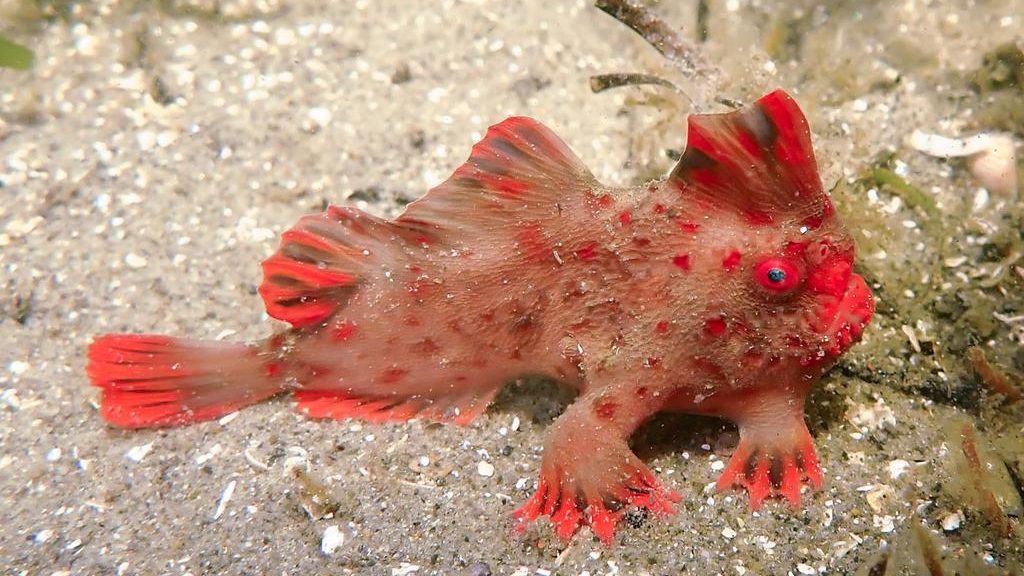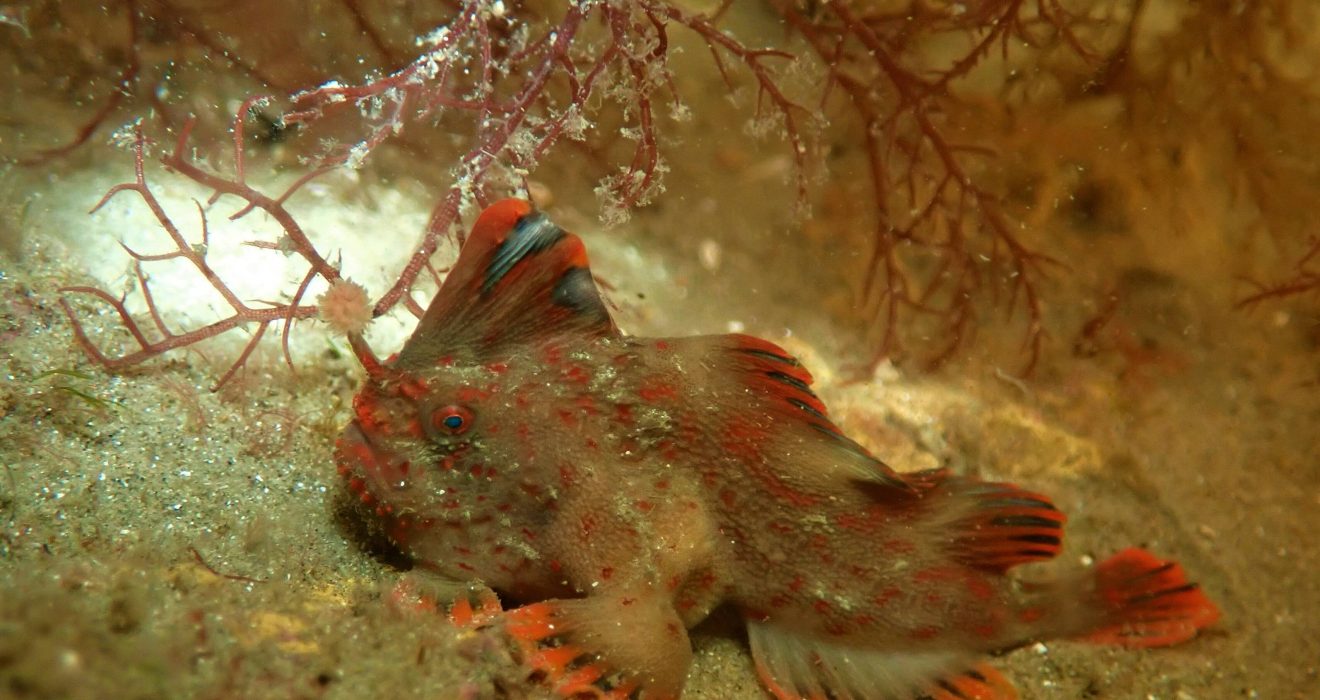To preserve the critically endangered red handfish species, a significant fraction of its decreasing population recently returned to its natural environment in Tasmania. This program, run by the Institute of Marine and Antarctic Studies (IMAS), underlines how important it is to preserve and revive this special marine species. Moreover, with an estimated 100 red handfish left in the wild, the odd step was taken in an attempt to lessen the damage that the impending marine heat wave posed. The highly endangered red handfish is listed on the International Union for Conservation of Nature’s (IUCN) Red List. In addition to the current rescue operations, scientists are looking at other ways to guarantee the red handfish’s long-term existence.
Appearance of Red Headfish:
As just a few inches in length, the red handfish (Thymichthys politus) is a tiny wonder of the sea. The red handfish is a tiny anglerfish that utilizes its underdeveloped fins to “walk” around the bottom of the ocean. It is fragile due to its small population distribution and restricted habitat, which consists of only two small patches of coral. Besides its tiny size, red headfish plays an important role in the ecosystem. They feed on small crustaceans present in the ocean water.

Rehabilitation Process:
After a successful summer rehabilitation program, about one-fifth of the severely endangered red handfish population is finally back to its natural habitat. In January, twenty-five red handfish were fished from the waters of southeast Tasmania’s Frederik Henry Bay in response to mounting fears about the potentially disastrous effects of rising ocean temperatures.
After several months of close monitoring and care, brings hope for the survival of Red Headfish. Out of the 25 species, 18 safely released back into the wild in the first few days of April. The other four are being kept in captivity as a safety precaution. Unfortunately, 3 died due to several challenges faced during the process of recovery and relocation.
However, a chance for the long-term existence of the species due to the successful return of most species to their natural atmosphere. Dr. Jehmina Stuart-Smith, in charge of the rescue mission, expressed satisfaction, and a deep sense of responsibility for making the mission effective. She said the task of removing and returning fish wasn’t very difficult, it probably seems like a fairly straightforward process. But considering the population size and the potential consequences of both action and inaction is a great pressure.
According to Dr. Stuart-Smith, the initial process of removal of difficult while the process is a bit easier. It’s a novel, in my opinion. Furthermore, I believe that this is something that we will likely see more of in the future. She emphasizes the necessity of quick response plans in a changing environment.
Government Aid:
With assistance from the Australian government, this proactive effort attempted to gain valuable time for the species’s survival. It also helps in reducing the immediate threat posed by the marine heatwave. The Australian government’s support of the rescue operation shows its unshakable commitment to stopping other extinctions and protecting diversity. A “national interest exemption” made it possible to legally acquire the red handfish from Frederik Henry Bay. He acknowledges the pressing need to alleviate stressors brought on by climate change and habitat degradation that endangers the recovery of the species.
Due to its limited habitat and unique biological category, the red handfish is particularly sensitive to environmental troubles. Dr. Stuart-Smith highlighted how proactive the rescue effort was and how important it was to reduce the negative effects of climate change on delicate oceanic ecosystems. There will be no more extinctions, according to the Albanese government’s dedication.
Future Prospects:
Dr. Andrew Trotter is in charge of the conservation breeding project at IMAS. He emphasized the need to reintroduce the red handfish in its native habitat despite the difficulties faced during the process. These are aquatic creatures that belong to the oceans. He is disappointed by the mortalities but fatalities in custody happen often. Although setbacks require additional research into health care and population dynamics, the captive breeding program continues to play a critical role in encouraging genetic variety and strengthening the population’s resilience.
Future tactics aimed at improving the effectiveness of interventions and guaranteeing the long-term survival of the red handfish population will based on the knowledge gained from this comprehensive conservation project. According to Dr. Trotter, the four handfish remain in captivity as a part of the captive breeding initiative. It will help to increase the population’s genetic variety.
Researchers believe that the temporary transfer of species will become usual. It’s due to the change in climate regularly. No matter how tiny or unimportant, we have a grave duty to safeguard and preserve the ocean’s inhabitants.
Community Collaboration:
An additional crucial element of red handfish conservation campaigns is community involvement. Ecologists can generate support for conservation activities and promote sustainable practices by educating locals about the suffering of the species and encouraging stewardship. People may help safeguard the red handfish and its environment by participating in educational programs, citizen science initiatives, and ecotourism opportunities. It can help people to develop a stronger connection to Tasmania’s abundant marine biodiversity. The restoration of habitat is essential to the red handfish population’s ability to recover.
Conclusion:
At last, against all the difficulties, a small and unusual creature struggles to survive in the deep seas of Tasmania. The highly endangered red handfish is capturing the interest of scientists and conservationists from all around the world. The red handfish tale acts as a moving reminder of the precarious equilibrium that exists between nature and humanity.
The red handfish and other endangered species are under the care of researchers, conservationists, and policymakers. They express a strong commitment to protecting Australia’s unique biodiversity. The successful restoration of these fascinating animals into their native environment emphasizes our common obligation to safeguard and maintain our marine ecosystems for future generations.
Such a massive preservation project is the perfect example of the collaborative effort and unshakable commitment essential to addressing complex issues. We can ensure a better future for Tasmania’s red handfish and the many other species that live in our oceans.

